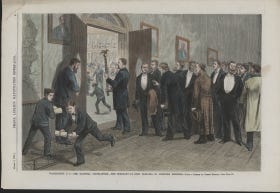#64: CIVICS 101: The Legislative Branch
Q&A #64: What are the customary proceedings when the House of Representatives meets?
Our American Government
Our American Government is a small book published by the House of Representatives for citizens and those who seek a greater understanding of the American interpretation of democracy. It follows a question-and-answer format and covers a broad range of topics dealing with the three branches of our Government, the electoral process, and the role of political parties.
The Savvy Citizen is reproducing the 169 questions-and-answers through a series of posts called Civics 101. Each post will contain the Q&A as well as some additional commentary to add historical context, fun facts, or anything we believe will add to our collective understanding of these topics.
Think of it as your adult Civics class but without the test!
Let’s keep at it.
SECTION: The Legislative Branch: The Congress
Congressional Rules and Procedures
Q&A #64: What are the customary proceedings when the House of Representatives meets?
The Speaker calls the House to order, and the Sergeant at Arms places the Mace (an ancient symbol of authority) on the pedestal at the right of the Speaker’s platform. After the Chaplain offers a prayer, the Speaker recognizes a Member to lead the House in the Pledge of Allegiance. Then the Journal of the previous day’s activities is approved, usually without being read.
Next, the Speaker may recognize a few Members to speak briefly on matters of importance to them, for no longer than one minute each. The House then is ready to begin or resume consideration of a bill, resolution, or conference report.
My Thoughts

The History, Art & Archives website for the House of Representatives has a great write-up about the the mace, an historic artifact. You can read the write-up here.
I’ve also included a small snippet below for your perusal:
Wherever and whenever the U.S. House of Representatives meets, this historic artifact is there. It is the mace. The mace is made up of three parts—a bundled shaft of 13 rods, a silver globe, and an eagle with spread wings. The bundled rods of the mace resemble fasces. Fasces, used in the ancient Roman republic, symbolize strength through unity. The bundled rods are much stronger together than they are separately.
While the mace, made by New York silversmith William Adams in 1841, intentionally looks like this ancient symbol, aspects of it are unmistakably American.
The 13 bundled rods of the shaft represent the original 13 states. Continents are etched into the globe atop the shaft, with the North American continent facing forward. Perched atop the globe is the national bird of the United States, the bald eagle, another symbol of strength.
The mace is a symbol of the authority of the Sergeant at Arms of the House of Representatives. In 1789, the House of Representatives passed a resolution that established the role of the Sergeant at Arms. The resolution stipulated that “a proper symbol of office shall be provided for the Sergeant at Arms, of such form and device as the Speaker shall direct.”
The first Speaker of the House, Frederick Augustus Conrad Muhlenberg, chose a symbol with a long legislative tradition and an even longer tradition as an implement of war. In the Middle Ages, the mace was widely used in Europe as a weapon. However, by 1789, the mace was commonly used as a ceremonial symbol of legislative power. For example, maces were used in the Houses of Parliament of the United Kingdom and the general assembly in colonial Virginia.
The Sergeant at Arms is tasked with maintaining decorum in the Chamber of the House of Representatives. A booklet about the mace, published in 1956, explained that the Sergeant at Arms may use the mace to achieve decorum. “Whenever, as seldom happened,” the booklet disclosed, “an individual Member became turbulent and seemed beyond the Speaker’s control, the Sergeant at Arms, on order of the Speaker [of the House], lifted the mace from its pedestal and ‘presented’ it before the offending person.” For example, a print in Frank Leslie’s Illustrated Newspaper depicts Sergeant at Arms John G. Thompson holding the mace on the floor of the House of Representatives. The caption reads, “The Sergeant-at-Arms of the House of Representatives, on the Night of January 31st [1877], giving a preliminary warning to disorderly members.”
Back next time with Q&A #65: What are the customary proceedings when the Senate meets?
Meanwhile, don’t forget that we’re organizing the post links on a single page available here.
xo,
Kelley for the Savvy Citizen Team
March 18, 2025





